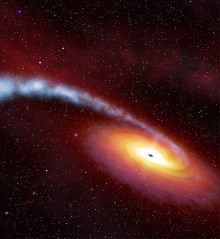Pulsar and Black Hole Combo Could Shed Light on Other Dimensions

Far from being the unstoppable monsters, black holes are thought to slowly lose mass over time through a process called Hawking Radiation. Emitting just a few particles at a time, the black holes shrink and are believed to lose their hold on orbiting matter in the process. However, if the extra dimensions described by String Theory exist then black holes should lose mass at a faster rate. These additional dimensions, Simonetti believes, would give additional means of escape for those Hawking Radiation particles.
Here’s where the Pulsar comes in. If scientists could find a black hole that has trapped a pulsar in its gravitational wake, then he may be able to measure the minute slippage as the black hole loses mass. Pulsars are spinning neutron stars that emit a jet of electromagnetic radiation. By measuring the variations in pulses, scientists could determine whether the black hole is losing mass slowly or quickly through many dimensions.
Simonetti’s team believes the difference should be noticeable. They’ve calculated that black holes loosing mass through extra dimensions should allow objects to drift a few meters away from black holes each year, as compared to single-universe loss which is so slow that it would be impossible to observe.
This all looks good as far as theoretical research goes, but actually experimentation would be a problem. First, scientists would have to find a black hole and pulsar pair somewhere in the sky that can be accurately observed using our Earthly technology. On top of that, the distances involved could mean that a drift of a few meters per year could take quite some time for us to observe. However, it is a tantalizing possibility presented on an epic scale that could shed light on the very nature of the universe in which we live.
(via New Scientist)
Have a tip we should know? tips@themarysue.com